
PI OBJECTIVES FOR THE EXECUTION OF BUSINESS STRATEGY
In the dynamic world of Business Agility, clarity of objectives and their rigorous monitoring are the cornerstones of a responsive and efficient organization.
Understanding and implementing relevant objectives is more than just a planning exercise; it is a crucial factor in instilling meaning and purpose in the activities of each team.
In the ever-changing world of Agile project management, the Scaled Agile Framework (SAFe) stands out as a robust model for coordinating efforts and aligning goals at scale.
At the heart of this framework are Planning Interval (PI) Objectives, essential milestones that connect strategy to execution.
However, effectively setting up and tracking PI Objectives can be a significant challenge for organizations.
In this article we will explore how to configure PI Objectives within your development value chain management tool and how Wiveez allows you to measure them at the ART Flow and Program Increment level.
PI Objectives – Définition
PI Objectives, or Planning Interval Objectives, as part of the Scaled Agile Framework (SAFe), are specific, measurable and achievable goals defined by Agile teams at the start of each Planning Interval (PI).
These objectives reflect what each team commits to delivering during the PI, which typically lasts 8 to 12 weeks.
They serve to align the work of teams with the broader strategic vision of the organization, ensuring that each effort directly contributes to achieving the company’s overall goals.
PI Objectives are evaluated in terms of expected business value, which allows stakeholders to understand the potential impact of each objective on the overall results of the organization.
PI Objectives & Features
In the Scaled Agile Framework (SAFe), PI Objectives and Features are closely related, but they serve distinct functions in the Agile planning and execution process at scale.
What is a Feature?
- Features are units of deliverable functionality in SAFe that provide value to users or customers. They are often larger than a user story, but must be small enough to be completed within a single Planning Interval (PI).
- Each Feature is defined in the ART Flow backlog and includes an expected benefit and acceptance criteria.
While Features focus on “what” is to be delivered in terms of functionality, PI Objectives focus on “why” and “how”. They link the execution work to the company’s broader strategy and goals.
At the end of the PI, teams evaluate their success by measuring the extent to which they have achieved their PI Objectives. This evaluation often takes into account the completeness of Features, but also integrates other factors such as quality, business value generated and strategic alignment.
In short, Features in SAFe represent the concrete pieces of work that need to be delivered, while PI Objectives represent the broader, strategic goals that these Features help to achieve within a given PI.
Enhancing the value of your PI Objectives
The evaluation of PI Objectives in SAFe is generally based on a scale of 1 to 10, aimed at measuring the importance and expected impact of each objective on value delivery.
Here is a proposed definition for each point on the scale, designed to help Product Managers and Business Owners assign the right value to an objective:
- Very Low Impact (1): The objective has minimal impact on value delivery and business results. It could be considered a maintenance or low-priority task.
Low Impact (2): The objective contributes slightly to value delivery, but remains secondary to other initiatives.
Modest Impact (3): The objective has a modest impact, making a recognizable but non-critical contribution to corporate strategy.
Medium-Low Impact (4): The objective is useful to the company’s strategy, but more important objectives prevail.
Medium Impact (5): The objective is of medium importance, playing a balanced role in strategy without being a top priority.
Medium-High Impact (6): The objective starts to become significant, contributing significantly to the achievement of strategic objectives.
High Impact (7): The objective is important and will have a strong impact on ART’s ability to deliver value. - Very High Impact (8): The objective is critical to the success of value delivery and has a strong influence on corporate strategy.
Vital Impact (9): The objective is vital to the realization of the company’s mission and must be achieved to ensure strategic success.
Mission Critical (10): The objective is absolutely essential and central to the company’s value delivery and success; its non-achievement presents significant risks to overall strategy.
When assigning a value to a PI Objective, it is crucial to consider not only the strategic importance of the objective, but also its impact on value delivery and its urgency. This scale can be adjusted and refined to suit the specific context and prioritization criteria of each organization using SAFe.
Reducing the PI Objectives valuation scale from 1 to 5 can help simplify the decision-making process and make the evaluation clearer:
Low Impact (1): The objective has minimal impact on value delivery. It may be an incremental improvement that does not fundamentally change performance or value delivery.
Moderate Impact (2): The objective is useful and provides a recognizable improvement, but is not crucial to the immediate success of the IP or overall strategy.
Medium Impact (3): The objective is of significant importance with a direct impact on corporate strategy and value delivery, but is not decisive in itself.
High Impact (4): The objective is very important, with a considerable impact on value delivery and significant repercussions on the strategic success of the IP.
Critical (5): The objective is essential to the success of the IP and to the company’s strategy. Its achievement is imperative, and failure to achieve it would present significant risks for the organization.
This 1 to 5 scale requires Product Managers and Business Owners to discriminate objectives more carefully, focusing on the essentials of what needs to be achieved to generate value and advance the corporate strategy. It is recommended to use this scale in a context where teams are sufficiently mature and have a clear understanding of the organization’s strategic priorities.
Configure PI Objectives in your management tool
Most tools for monitoring a development value chain do not offer PI Objectives monitoring.
Let’s see how PI Objectives could be configured in a tool like Jira.
Jira does not offer an “Objective” ticket type as standard. So you need to create a new type of ticket, which you can name “Objective” and which can be used at both ART Flow and Team Flow levels.
You can associate the following fields with this ticket type, which will enable you to monitor the management of the Objective:
- A title
- Description
- Expected value (PBV – Plan Business Value)
- Actual business value (ABV)
- Committed or uncommitted target indication (Committed ; Uncommitted)
- Associated Planning Interval
- Associated team
Vous pourrez ensuite suivre l’avancement des Objectives d’un PI ou d’une Equipe via un tableau de bord au niveau ART Flow et Team Flow.
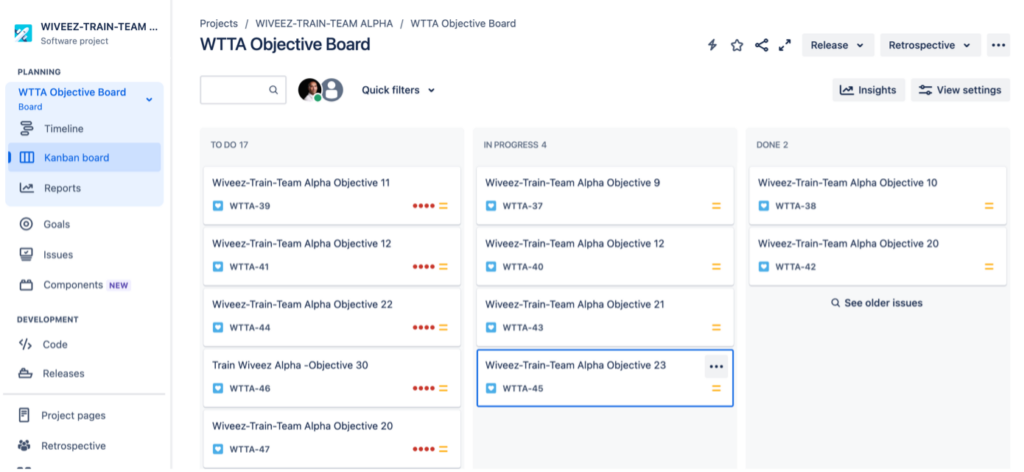
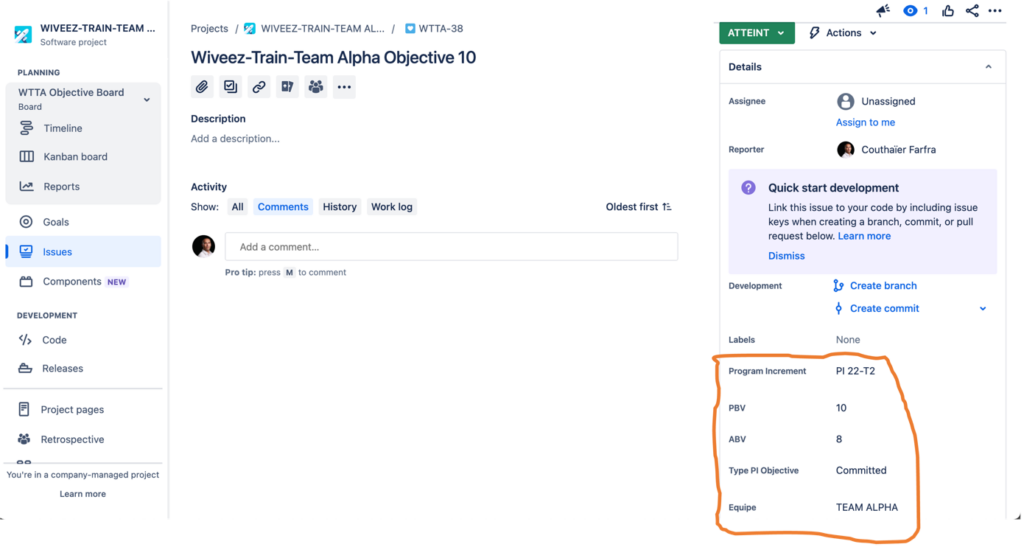
Manage your PI Objectives with Wiveez
Version 4.3 of Wiveez offers a new solution for tracking ART Flow performance indicators and PI Objectives.
Configuring PI Objectives tracking
Once the ART Flow has been created, Wiveez lets you configure the elements that will be used to track PI Objectives.
Select the type of Jira ticket associated with the PI Objectives:
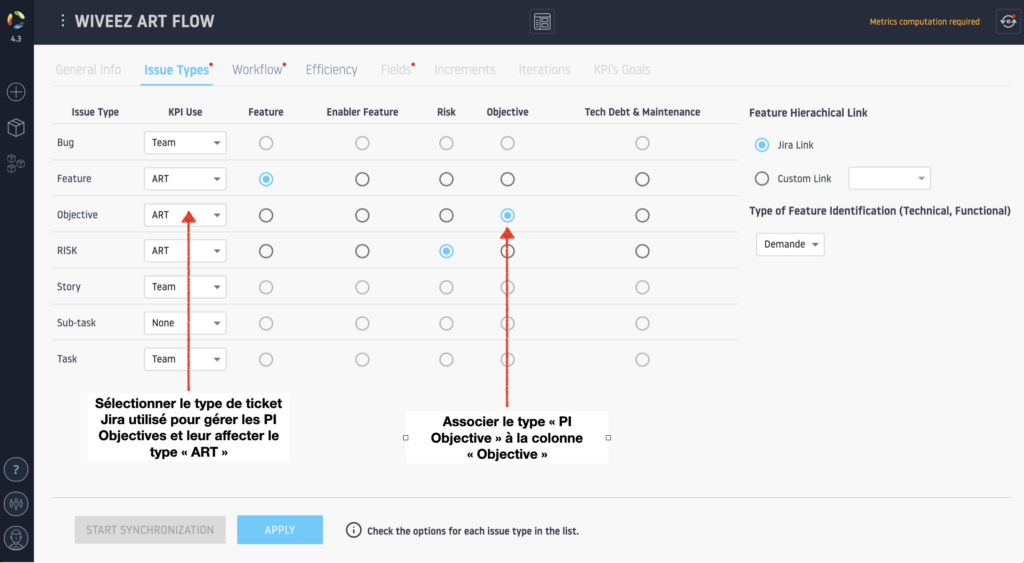
Select the Objective Jira PI fields:
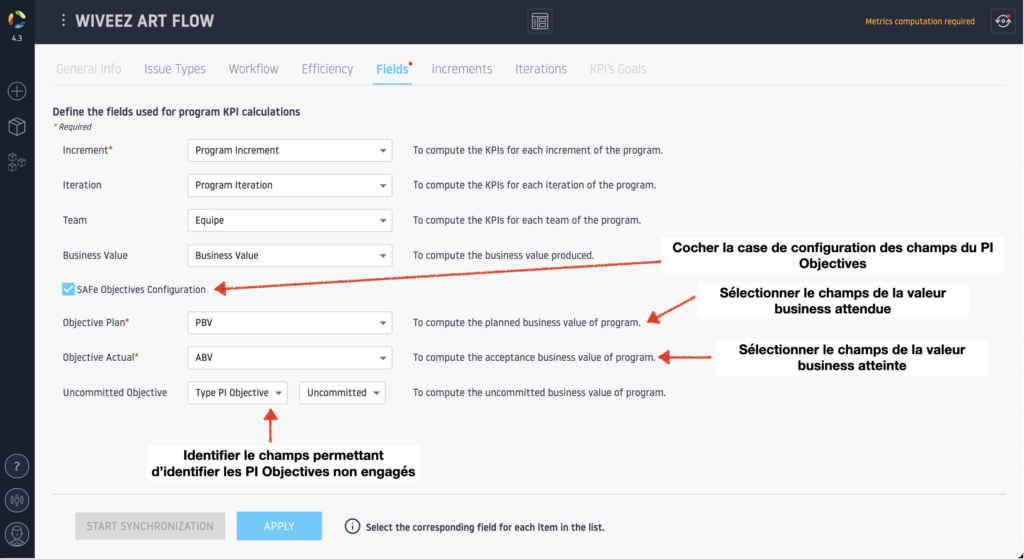
Measure & Track your PI Objectives
Les PI objectives peuvent être suivis au niveau de l’ART Flow, mais également au niveau de chaque Incrément d’un ART Flow.
PI Objectives can be tracked at ART Flow level but also on each Planning Interval of your ART Flow.
PI Objectives – ART Flow
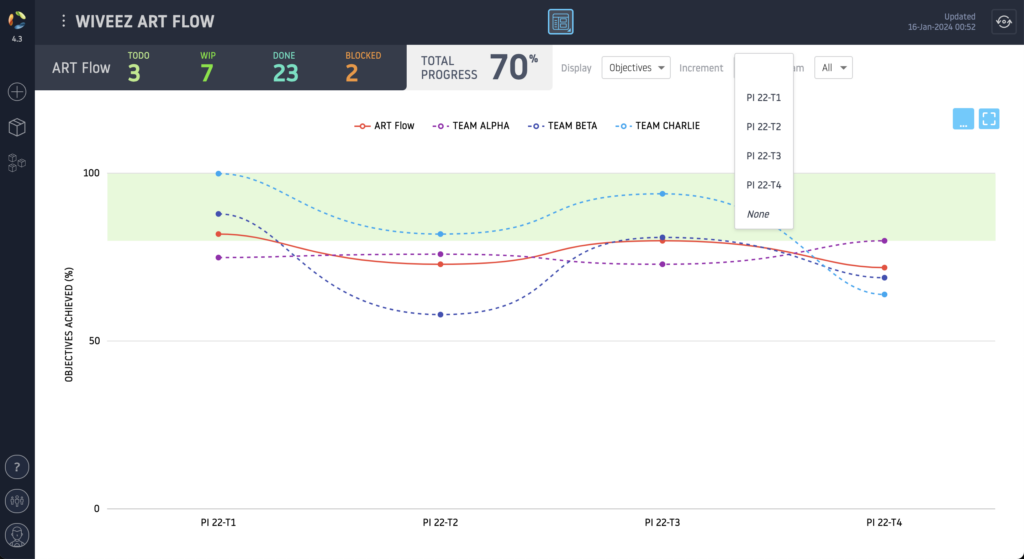
PI Objectives can be tracked by Planning Interval and by Team of your Team Flow.
You can also show the detail of each PI Objectives for a Planning Interval and for a Team.
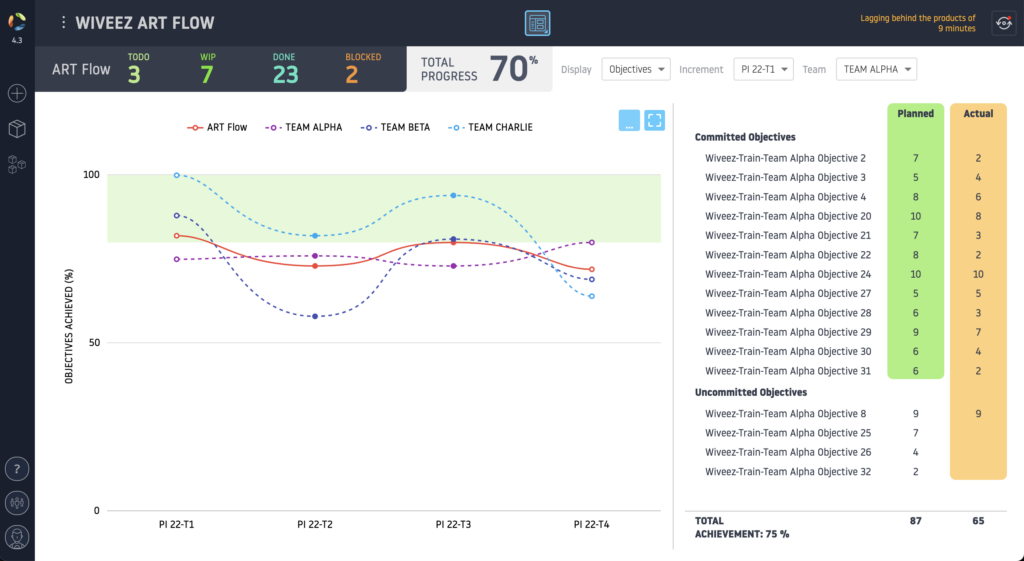
PI Objectives – PI Flow

Les PI Objectives peuvent être suivi au niveau du tableau de bord d’un Planning Interval, par Equipe.
For each Planning Interval you can tracked their PI Objectives, in whole and by team.
Find out more…
PI Objectives & OKR
In the Scaled Agile Framework (SAFe) PI Objectives & OKR have a distinct roles but complementary.
While PI Objectives are focus on alignment et value delivery in each Planning Interval of ART Flow, OKRs manage the strategy and lead the continuous improvement at each level of an organization.
The both approach, althought different, complete each other to lead teams in a common and valuable objectives and improve the strategic alignment, transparency and continuous improvement of the organization.
The Sprint Goals in Scrum
Sprint Goal Scrum and PI Objective SAFe both help teams to lead their efforts for increase the delivery of value, but they operating in a different levels and a different cadences.
- Sprint Goal: It is managed in a short period, typically between 1 at 4 weeks and concerne usually only one Scrum Team.
- SAFe PI Objective: It is managed in a Planning Interval, usually between 8 at 12 weeks and usually concern few Teams working in a same ART Flow.
Although sprint goals in Scrum and PI Objectives in SAFe are not managed in the same way due to these differences, the fundamental principles of goal definition, focus on value delivery and performance measurement remain consistent. Both require clear definition, regular monitoring and transparent communication to ensure that teams remain aligned with the organization’s goals.
In a Sprint, teams will generally measure the velocity achieved at the end of the Sprint, representing the number of Story Points or requests processed. This measure does not correspond to the achievement of a Sprint Objective, but rather to the team’s ability to deliver on its commitments at the start of the Sprint, the ratio between commitment and velocity giving predictability.
To enhance the value of your Sprint Objectives, you can use the same principle as for PI Objectives, valuing them at the start of the sprint and measuring their level of achievement at the end of the sprint.
Conclusion
The implementation of Planning Interval (PI) Objectives is an essential step in ensuring that team efforts are aligned with the company’s overall strategies and objectives in a SAFe environment. These objectives are not just indicators of direction, but catalysts for success and innovation.
However, to maximize their effectiveness, meticulous attention must be paid to their configuration and monitoring.
A project management tool such as Jira becomes an indispensable ally. It must enable PI Objectives to be clearly and precisely defined, while ensuring total visibility and transparency for all stakeholders. The tool must offer functionalities that facilitate the configuration of these objectives.
Jira combined with Wiveez enables teams to measure and track the progress of PI Objectives, at ART Flow level, at Planning Interval level (PI Flow) and at Team level (Team Flow).
Ultimately, the effective configuration and tracking of PI Objectives via a dedicated tool is not simply a matter of project management; it is at the heart of Agile transformation and Business Agility. By adopting this tool, organizations can not only ensure strategic alignment, but also foster a culture of continuous improvement, transparency and operational excellence.



